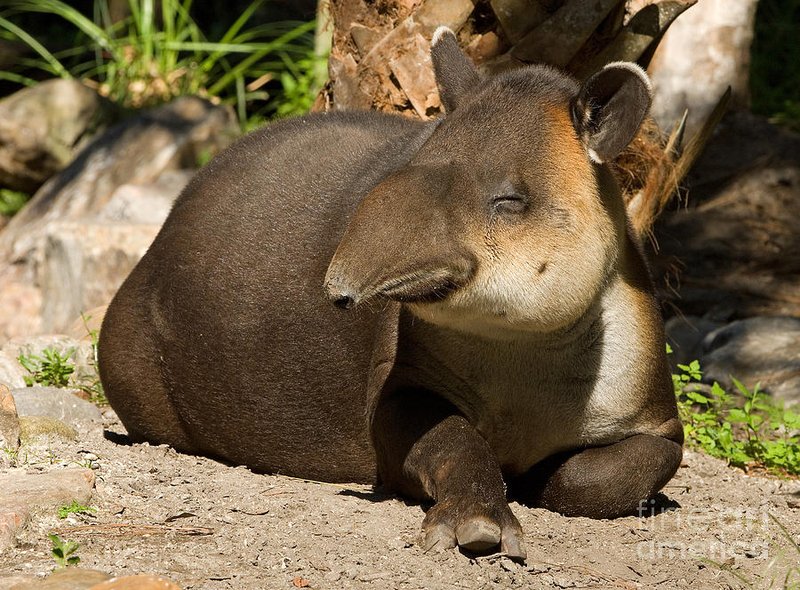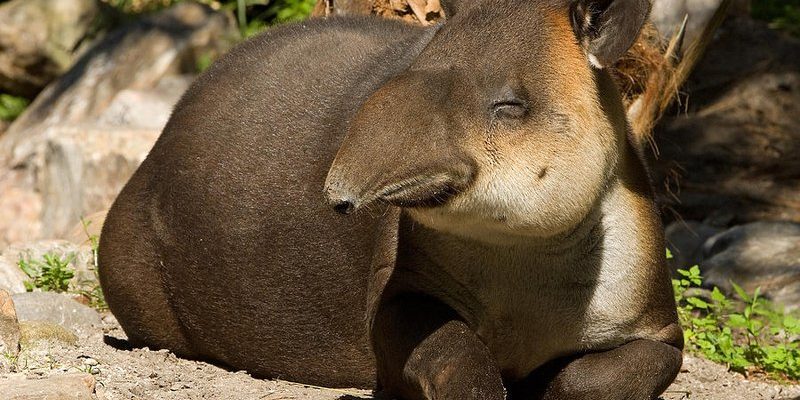
The Baird’s tapir, native to Central America, has its own set of unusual traits that set it apart from other mammals. Imagine wandering through the lush jungles of Belize or the cloud forests of Costa Rica and suddenly spotting this gentle herbivore munching on leaves. These creatures play a crucial role in their ecosystems, acting as seed dispersers and helping to maintain forest health. Now, let’s explore some truly captivating facts about the Baird’s tapir that will make you appreciate this incredible animal even more.
1. Size and Weight
The Baird’s tapir is one of the largest land mammals in Central America. On average, adults weigh between 400 to 900 pounds and can grow up to 8 feet long! To put that in perspective, that’s like having a hefty dog that could easily outweigh you. Despite their size, they are surprisingly good at navigating through dense vegetation. Their notable, rounded bodies and short legs allow them to traverse their natural habitats with ease.
Interestingly, the size of a Baird’s tapir can vary depending on its habitat. For instance, tapirs living in dense jungles may be smaller than those found in more open environments. This size adaptation helps them find food more efficiently and escape from predators. Imagine being a small tapir trying to squeeze through thick bushes—being smaller can really mean survival!
2. Habitat and Distribution
Baird’s tapirs call Central America home, ranging from southern Mexico to western Colombia. They prefer tropical forests and grasslands, often near rivers and streams. These areas provide a steady supply of water, which is essential for their survival. If you picture a tropical jungle, complete with tall trees and leafy undergrowth, you’ve just about captured their ideal environment.
Unfortunately, the Baird’s tapir is considered vulnerable due to habitat loss and hunting. As human activity expands, these gentle giants are losing their homes. This situation is a critical issue; tapirs are important for their ecosystems, as they help with seed dispersal. You might think of them as gardeners of the rainforest, spreading seeds and helping new plants grow wherever they roam.
3. Diet and Feeding Habits
Baird’s tapirs are herbivores, meaning they primarily eat plants. Their diet consists of a mix of leaves, fruits, and aquatic plants. They are known to be quite picky eaters, often targeting specific types of foliage. Think of them as the food critics of the forest—choosing only the best bites!
One of their remarkable traits is their ability to consume hard-to-reach foods. With their long, flexible snouts, Baird’s tapirs can grab leaves and fruits from high branches or even underwater plants. It’s like watching a pro chef skillfully retrieve the finest ingredients from a busy market. This adaptability not only feeds them but also helps disperse seeds, contributing to the health of their ecosystem.
4. Unique Physical Features
What really makes Baird’s tapirs stand out are their distinctive physical features. They have a unique, elongated snout similar to that of an anteater, which helps them reach food in tight spots. This nose isn’t just for show; it’s incredibly sensitive, allowing them to smell food and detect predators.
In addition, their thick skin is covered in coarse hair, which can be dark brown to gray. This coloration provides excellent camouflage among the forest shadows. Picture this: a Baird’s tapir resting quietly under a tree—it’s almost like it disappears into the environment! Their large, rounded bodies, short legs, and small, rounded ears give them a somewhat adorable appearance, akin to a living teddy bear.
5. Behavior and Social Structure
Baird’s tapirs are mostly solitary animals, preferring to live alone or in mother-offspring pairs. The mothers are dedicated caregivers, often staying with their young for up to a year. During this time, the mother teaches her calf everything it needs to know, from finding food to staying safe from predators.
While they are generally shy, you might catch a glimpse of them being more active during twilight or at night. This nocturnal behavior helps them avoid predators like jaguars and tigers. Imagine wandering through a dimly lit jungle, then suddenly, out of the shadows, you spot a tapir grazing peacefully—it’s a pretty magical moment.
6. Reproduction and Lifespan
Baird’s tapirs have a unique reproductive cycle. The females typically go into estrus (a period of fertility) every 12 to 13 days. After a gestation period of about 13 months, a single calf is born. Think about that—mothers must nurture their little ones for a long time before they can roam freely in the wild!
Once born, tapir calves have a distinct striped coat that provides camouflage in the wild. It’s a little like nature’s way of giving them a protective outfit. As they mature, the stripes fade, and they take on their adult coloration. In the wild, Baird’s tapirs can live for about 25 to 30 years, which is impressive for such large mammals.
7. Conservation Status and Threats
Despite their fascinating traits, Baird’s tapirs face numerous threats that have led to their classification as vulnerable by the IUCN. Habitat loss due to deforestation, agriculture, and urban development has dramatically reduced their natural homes. Moreover, hunting poses a significant risk as some communities may target them for meat or other uses.
Conservation efforts are underway, focusing on protecting their habitats and increasing awareness about the importance of preserving this species. Imagine local communities coming together to create wildlife reserves, ensuring that these gentle giants still roam the earth. It’s all about finding a balance between human development and animal protection.
8. Cultural Significance
In some Central American cultures, the Baird’s tapir is considered a symbol of strength and resilience. They appear in local folklore and mythologies, representing the connection between nature and the community. Understanding the cultural significance of Baird’s tapirs not only highlights their importance but also fosters appreciation for wildlife conservation.
You might hear stories about tapirs being guardians of the forest or tricksters that teach lessons about harmony with nature. These tales help people connect with the tapir on a personal level, encouraging efforts to protect them and their habitats.
9. Fascinating Facts and Trivia
Let’s wrap things up with some fun trivia about our friend, the Baird’s tapir! Did you know that they can swim remarkably well? Their bodies are built for buoyancy, and they often take to the water to escape threats or to cool off. Picture a tapir gracefully paddling through a river like a natural-born swimmer.
Another interesting fact is their vocalizations. Baird’s tapirs communicate with a range of sounds, including whistles, grunts, and even snorts. It’s like they have their own language filled with every sound you’d expect from a playful friend.
10. How You Can Help
Want to make a difference? Supporting wildlife conservation organizations can help protect Baird’s tapirs and their habitats. Educating yourself and others about these creatures can also raise awareness of their plight.
You can even advocate for sustainable practices that lessen the impact on the rainforest. Simple actions, like reducing plastic use or supporting eco-friendly products, contribute to a healthier environment for these gentle giants.
In conclusion, the Baird’s tapir is more than just a fascinating animal; it plays an essential role in maintaining the balance of its ecosystem. By learning about and appreciating these unique creatures, we can help ensure that they continue to thrive for generations to come. So next time you hear about Baird’s tapirs, you’ll know just how special they are!

